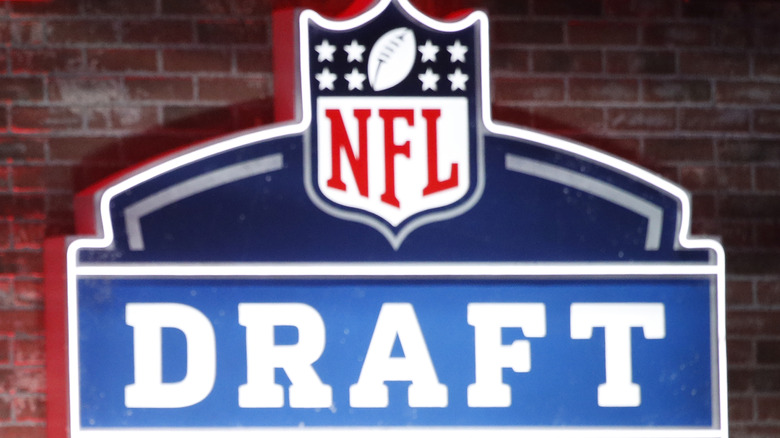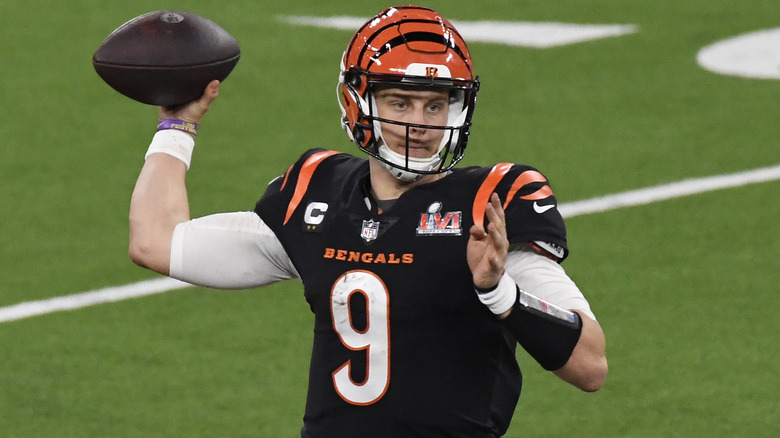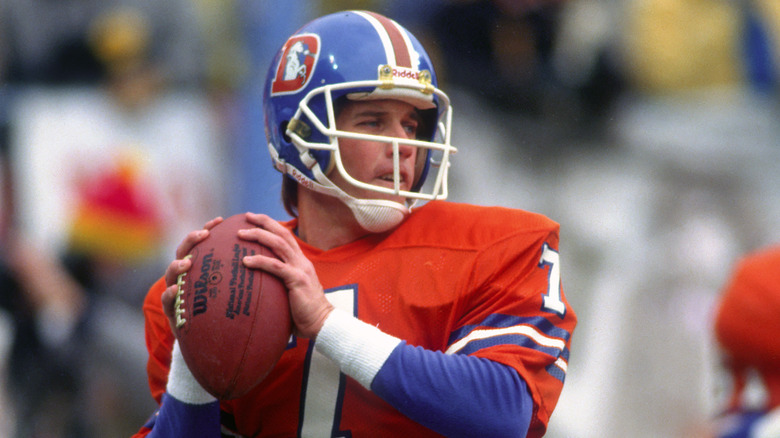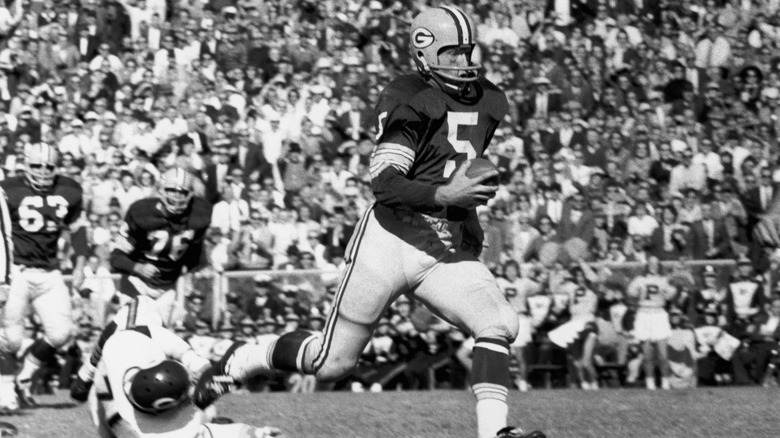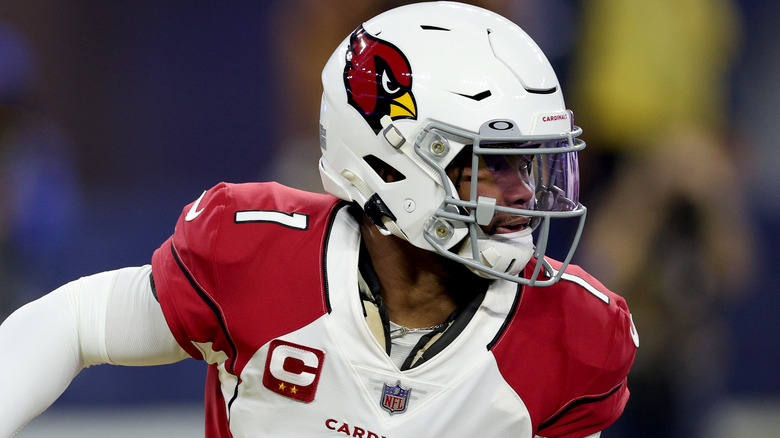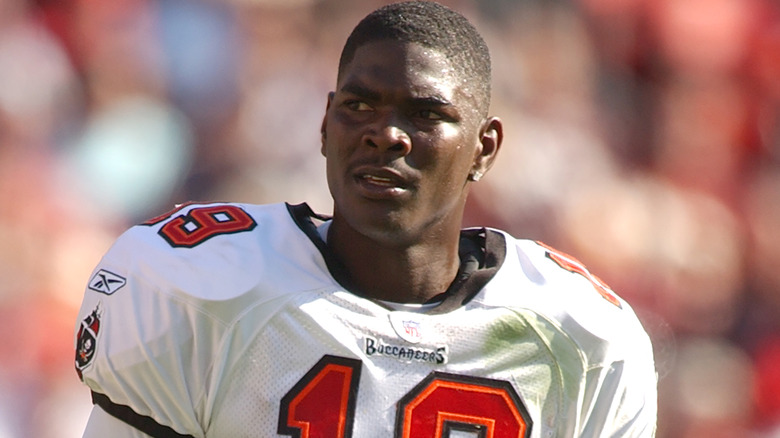Which College Teams Have The Most No. 1 NFL Draft Picks Of All Time?
Taking place over a span of three days (as it's been since 2010), the NFL Draft is followed by millions of football fans in the last week of April, and it's easy to see why. Each year, hundreds of top college prospects are selected by the NFL's 32 teams, and while it's hard to predict on draft day whether the cream of the crop will rise to the proverbial top, the seasons that follow tell the whole story — your favorite team may end up with someone of Peyton Manning's caliber at No. 1, but may also regret using that high pick on the next Ryan Leaf or JaMarcus Russell. Or your favorite team might get lucky on the last day just like the New England Patriots did in 2000 when they used their sixth-round pick on an unheralded prospect by the name of Tom Brady.
Regardless of whether the NFL Draft's No. 1 overall selection becomes a future Hall of Famer or an outright bust, there are just some college teams that tend to produce more top picks than others. In fact, in the 80-plus years of the draft, there are three teams that share the lead. But before we get to those educational institutions and find out which of them have produced the most No. 1 choices, let's look at some honorable mentions, starting with the three schools with three first overall selections.
Three top picks: LSU, Ohio State, Texas
As mentioned, we're starting out with some of the runners-up, and tied at seventh place with three first overall draft picks are Louisiana State University, Ohio State, and Texas, according to Sports Illustrated. The first LSU player to get selected with the NFL's No. 1 pick was tight end/running back Billy Cannon in 1960, though he opted for the AFL's Houston Oilers over the NFL's Los Angeles Rams and had a successful career with two All-Pro selections and three AFL championships. Many decades later, in 2020, Joe Burrow went to the Cincinnati Bengals, and so far, it looks like "Joe Shiesty" is on his way to what should be a stellar career after just two pro seasons. Oh, and LSU also produced another first-overall quarterback in 2007 — JaMarcus Russell, who had an extremely disappointing, abbreviated stint in the pros.
Ohio State's No. 1 overall selections didn't exactly set the world on fire for the most part — linebacker Tom Cousineau (1979) only had an average career, while defensive tackle Dan Wilkinson (1994), despite spending 12 years in the NFL, was one of many Bengals first-rounders from the '90s who failed to live up to expectations. Orlando Pace (1997), however, was a seven-time Pro Bowl offensive tackle who was inducted into the Pro Football Hall of Fame in 2016.
It's been a while since someone from Texas was drafted first overall — defensive end Kenneth Sims (1982) was the last Longhorn with this distinction, and his NFL career was pretty underwhelming. Prior to that, though, linebacker Tommy Nobis (1966) and running back Earl Campbell (1978) were far more successful and were both Pro Bowl regulars at their respective positions — Campbell was, in fact, enshrined in Canton despite the fact his career was shortened by injuries.
Four top picks: Auburn, Georgia, Stanford
Three college teams are tied at fourth place with four No. 1 overall NFL draft picks, starting with Auburn, which produced great top picks such as running back Bo Jackson (1986) and quarterback Cam Newton (2011) but also a couple of not-so-great ones in running back Tucker Frederickson (1965) and linebacker Aundray Bruce (1988). If we're counting the AFL Draft, the Tigers actually have five top picks, as offensive tackle Ken Rice was chosen first overall by the Buffalo Bills in 1961.
You may need to ask your grandparents about three of Georgia's top NFL draft picks. But if you'd rather hear it from us, running back Frank Sinkwich (1943) was named league MVP in his second pro season, and Charley Trippi (1945), also a running back, led the Chicago Cardinals to a championship in 1947 and was inducted into the Pro Football Hall of Fame in 1968. Offensive/defensive end Harry Babcock (1953) turned out to be a bust, but thankfully, that wasn't the case more than five decades later when Matthew Stafford (2009) went to the Detroit Lions — he also won his very championship with the Los Angeles Rams at Super Bowl LVI.
Things didn't get off to a great start for Stanford as far as first overall picks go, as Bobby Garrett (1954) played just nine NFL games as a backup quarterback before joining the Air Force and retiring from football in 1957. Thankfully, the next three Cardinal signal-callers who were picked first — Jim Plunkett (1971), John Elway (1983), and Andrew Luck (2012) — all went on to enjoy NFL success, win Super Bowls, and live up to their draft billing.
Five top picks: Notre Dame
With those six schools out of the way, we have a three-way tie at the top, starting with Notre Dame as the first of these teams with five No. 1 overall draft picks. A look at Pro Football Reference's list of top draft picks shows that it's been five decades since a Fighting Irish player was the top selection, and that was defensive end Walt Patulski, way back in 1972. By most accounts, he was a bust of sorts, retiring at the age of 28, with his Bills coach, Lou Saban, telling the Los Angeles Times that Patulski "just went through the motions."
While the numbers and the brevity of their careers may suggest that quarterbacks Angelo Bertelli (1944) and Boley Dancewicz (1946) also flopped, Leon Hart (1950) easily avoided this distinction. A 6-foot-5, 257-pound right end (not tight end — left/right end were old-timey offensive positions), Hart was a one-time Pro Bowl and All-Pro selection and won three championships with the Detroit Lions — yes, there was a time when the Lions actually won NFL championships.
Easily the most successful of Notre Dame's five No. 1 picks is Paul Hornung, who went to the Green Bay Packers in 1957. Mainly utilized as a running back and kicker, the "Golden Boy" won four (pre-Super Bowl) league championships under legendary head coach Vince Lombardi and was part of the first-ever Super Bowl-winning team, but didn't get to play (via The New York Times). Hornung's career was also marred by controversy, as he was suspended for the entire 1963 season for gambling on NFL results, though he eventually got enshrined in the Pro Football Hall of Fame in 1986.
Five top picks: Oklahoma
The Oklahoma Sooners had a couple of No. 1 overall picks within a span of five years, with defensive end Lee Roy Selmon (1976) and running back Billy Sims (1980) both living up to their lofty status and making the Pro Bowl multiple times — Selmon made it to the Pro Football Hall of Fame after nine seasons with the Tampa Bay Buccaneers, while Sims was a top-flight RB for the Detroit Lions before a knee injury cut his career short after just five seasons (via the Detroit Free Press). It would be a good 30 years before Oklahoma had another first overall pick (and the first of three No. 1 overall quarterbacks), and that was Sam Bradford in 2010 — he had a decent, yet ultimately disappointing career that ended before the 10-season mark.
Fortunately for Kyler Murray (2019), his career has gone very smoothly thus far, and he's helped the Arizona Cardinals stay competitive in recent campaigns ... despite the supposed "curse" that has haunted them for decades. The jury's still out on Baker Mayfield, who was chosen one year before Murray, as he had a terrible 2021 season for the Cleveland Browns and might be headed elsewhere after the team traded for the far more effective (and far more controversial) Deshaun Watson.
Five top picks: USC
If there was a tiebreaker based on the success-to-failure ratio for first overall draft picks, the University of Southern California would win it over Oklahoma and Notre Dame, because none of their five top picks turned out to be draft busts in any way, shape, or form. We don't need to remind you about what happened to O.J. Simpson (1969) in the years after his football career ended, but for what it's worth, he was one of the NFL's best running backs of the 1970s and a great football player by any measure. One year before Simpson entered the league, offensive tackle Ron Yary became the first Trojan selected at No. 1 in the NFL Draft, and his Pro Football Hall of Fame resume includes six All-Pro selections and one NFL championship with the Minnesota Vikings.
Running back Ricky Bell (1977) seemed destined for greatness after a strong start with the Tampa Bay Buccaneers, but as The New York Times noted, he retired early due to an illness that he would eventually die from in 1984 at only 29 years old. In 1996, wide receiver Keyshawn Johnson became the fourth USC Trojan picked first overall, and aside from winning a Super Bowl with the Buccaneers, he had four 1,000-yard seasons and made the Pro Bowl three times. Finally, we have quarterback Carson Palmer (2003), who was also a three-time Pro Bowl selection in a career that lasted a good 15 seasons.
